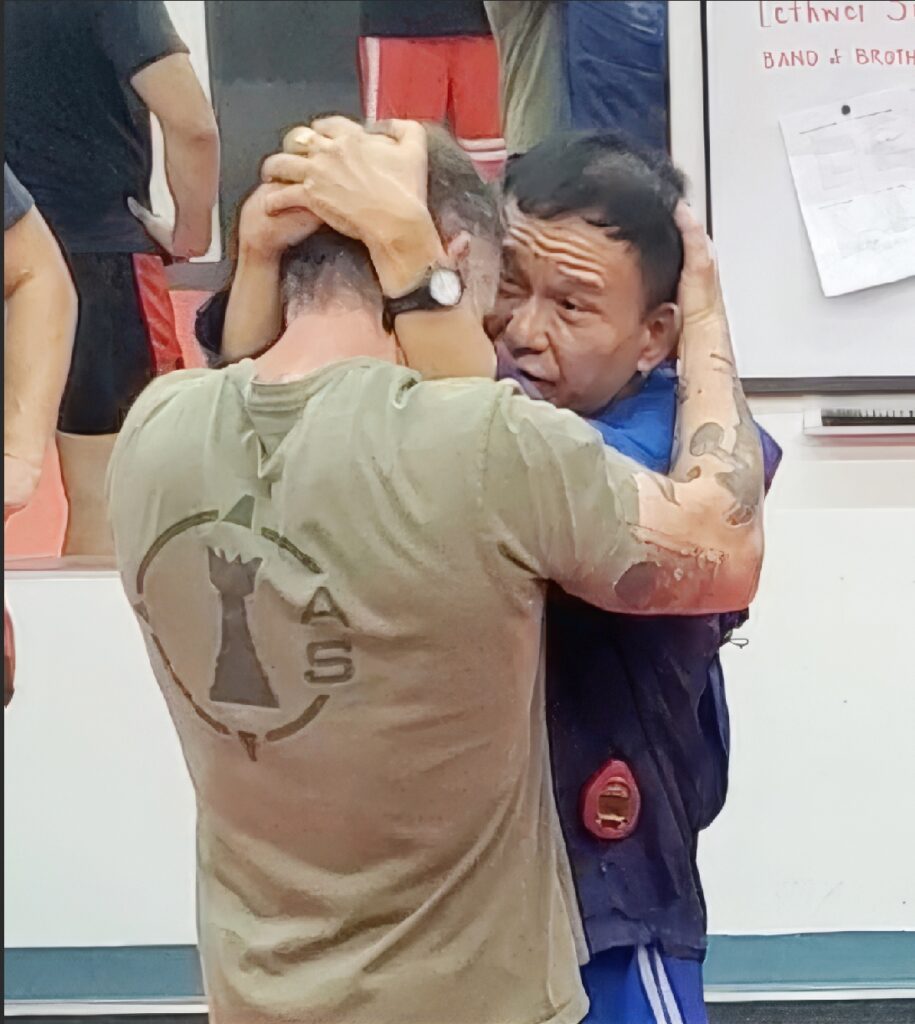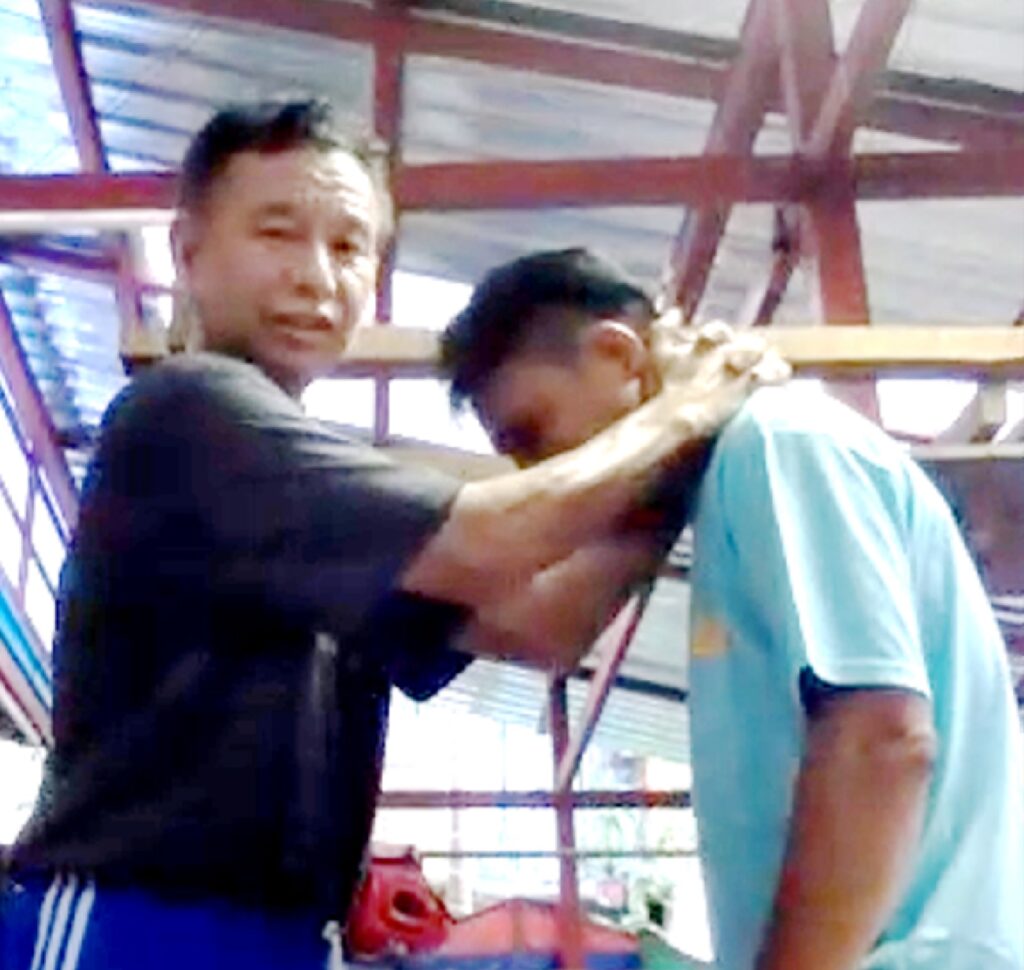
Academy Menu
Module Menu
Module 1 Lessons
Techniques
Tactics
Culture
Knowledge
Technique
Interlaced Grip
Learning Objectives
At the completion of this lesson, including review and applicable practice, the instructor candidate will be able to:
- Compare and contrast the cup grip and the interlaced grip for the clinch.
- Explain the tactical advantages of the interlaced grip in the clinch.
- Demonstrate the interlaced grip in the clinch.
- Demonstrate followup techniques when using the interlaced grip in the clinch.
Overview
Allowing bare-fists in Lethwei provides the unique ability to use of the interlaced grip in the clinch. Without the limitations of gloves, ability to interlace the fingers in the clinch as well as execute unencumbered gripping provides both technical and tactical advantages to the Lethwei fighter.
Interlacing the fingers for gripping in the clinch provides a significant leverage advantage. It also allows the application of various compliance techniques that gloved hands do not allow. Bare hands provide the ability to apply single handed grips and clinch techniques that are not afforded in combat sports that require gloves..
Key Concepts
- The cup grip and the interlaced grip have different purposes in the clinch.
Instructional Media
Cup grip in the clinch

Interlaced grip in the clinch

Interlaced grip

Developmental Practice
Practice the new technique frequently and systematically. All techniques should be practiced from both orthodox and southpaw leads. Begin by practicing the technique slowly without contact. From there, progress to solid targets such as focus mitts. Add the technique to your regular training sessions and explore it use within your current fighting art toolbox. Once you are executing the technique proficiently, proceed to the next level of technical development.
Make a video recording of your technique execution in the air and then against focus mitts or another type of pad. Review the video of your technique execution. Evaluate your execution of the techique in terms of mechanics and efficiency. Make any necessary corrections in your practice of the technique. Be sure to use caution when practicing techniques against focus mitts, heavy bag or pads of any type, be sure to execute at a reduced speed and force. Gradually increase intensity to minimize the risk of injury.
Functional Combinations
Practice the new combinations frequently and systematically. All combinations should be practiced from both orthodox and southpaw leads. Start the combination learning process slowly without contact and progress to focus mitts and/or other targets. Add them to your regular training sessions and explore including those that work for you in your toolbox.
- cup grip to interlaced grip clinch
- interlaced grip clinch – push knee
- interlaced grip clinch – head shake
It is suggested that you video the combinations similar to the process used in your technique video analysis. Using the video recording of the combinations, evaluate your execution of them in terms of mechanics, fluidity, and efficiency. Make any necessary corrections in your practice of the combinations. Be sure to use caution when practicing combinations against focus mitts, heavy bags or pads of any type. Execute them at a reduced speed and force and gradually increase intensity to minimize the risk of injury.
Review
- Perform the interlaced grip in the clinch.
- What are the advantages of the interlaced grip used in the clinch?
- What are the disadvantages of the interlaced grip in the clinch?
- Perform the push knee while using the interlaced grip in the clinch.
Instructor Level 1 Assessment and Review
Knowledge of and proficiency with this technique is a required component for the Thut Ti Lethwei Global Instructor Level 1 (Saya Dit) Pathway. During the official Instructor Level 1 assessment and review, Instructor Candidates may be asked to describe this technique verbally and/or in written format. Instructor Candidates may also be asked to demonstrate this technique in isolation and/or in an applied context.
Thut Ti Lethwei Global Academy Disclaimer
The information provided on Thut Ti Lethwei Global Academy (lethwei.net) is intended for general informational and educational purposes only. The content on this Website is not intended as a substitute for instruction or direction from a professional combat sports coach or martial arts instructor. The content is also not intended as a substitute for medical direction, advice, diagnosis, or treatment from a health care professional. Always seek the advice of your physician or other qualified health provider with any questions you may have regarding a medical condition or th e safety of participating in any physical activity.
Not Medical Advice: The content on this Website is not intended to be a substitute for professional medical advice, diagnosis, or treatment. Always seek the advice of your physician or other qualified health provider with any questions you may have regarding a medical condition.
Consult a Professional: It is essential to consult with a healthcare professional before starting any new activity program, diet, or exercise routine. Your individual training goals should be discussed with a qualified healthcare provider who can provide personalized recommendations.
Assumption of Risk: Participation in physical activity and exercise carries inherent risks, and by using the information provided on this Website, you acknowledge and voluntarily assume these risks. Always exercise caution and common sense when engaging in physical activities.
Accuracy of Information: While we strive to provide accurate and up-to-date information, the content on this Website may not always reflect the most current research or medical guidelines. We do not guarantee the accuracy, completeness, or timeliness of the information presented.
Responsibility: You are responsible for your health and safety when engaging in any combat sport, martial art, or fitness program, individual exercise, or dietary practice discussed on this Website. Thut Ti Lethwei Global Academy, its authors, contributors, and affiliates disclaim any liability for any injury, loss, or damage incurred as a result of the use or reliance on the information provided on this Website.
Changes to Disclaimer: Thut Ti Lethwei Global Academy reserves the right to modify or update this disclaimer at any time without prior notice. It is your responsibility to review this disclaimer periodically for any changes.
By using Thut Ti Lethwei Global Academy website, you agree to the terms of this disclaimer. If you do not agree with these terms, please refrain from using this website.
